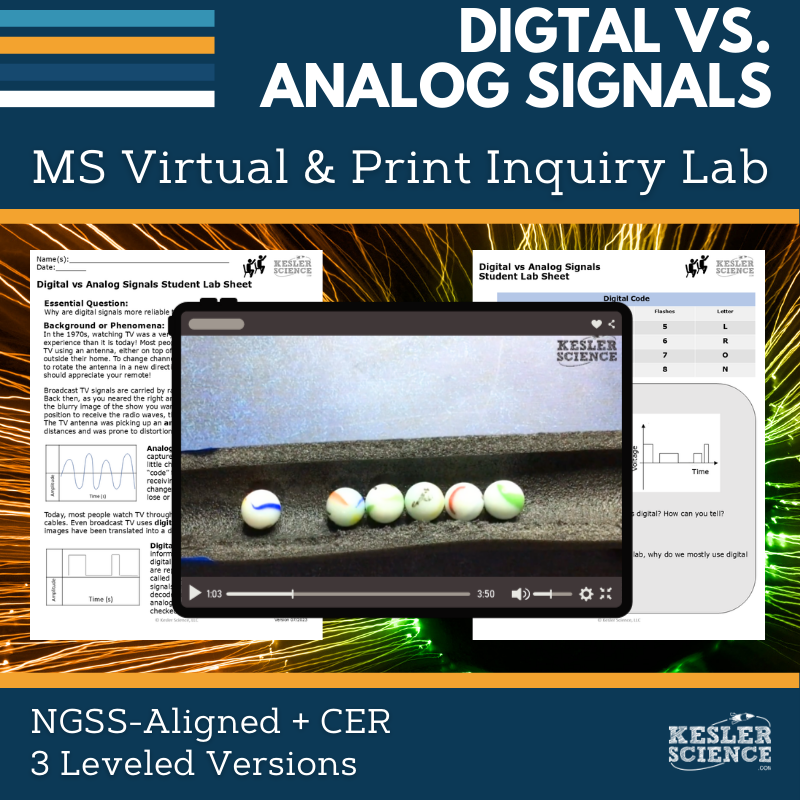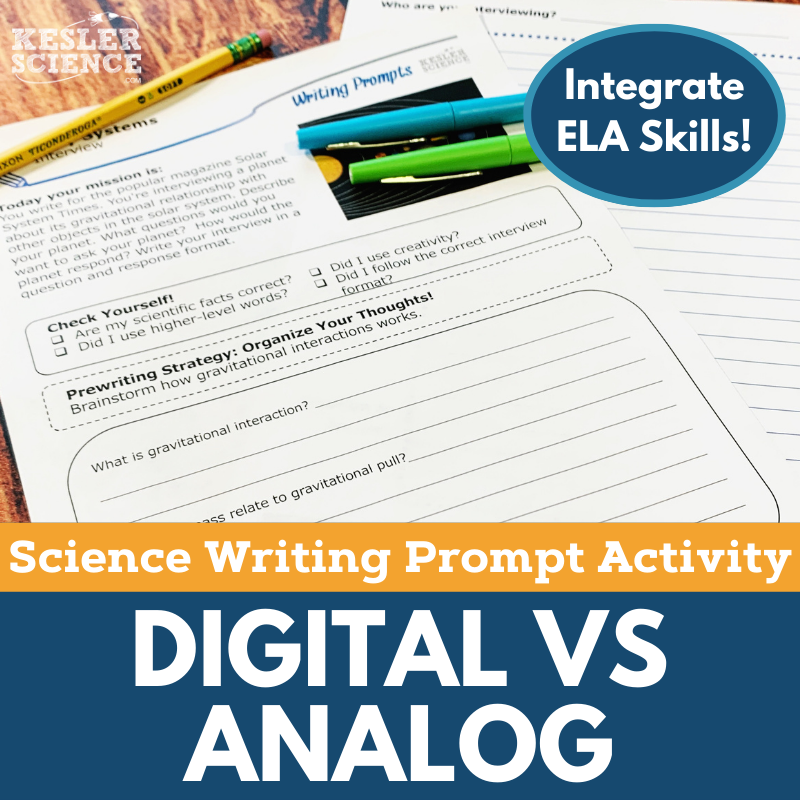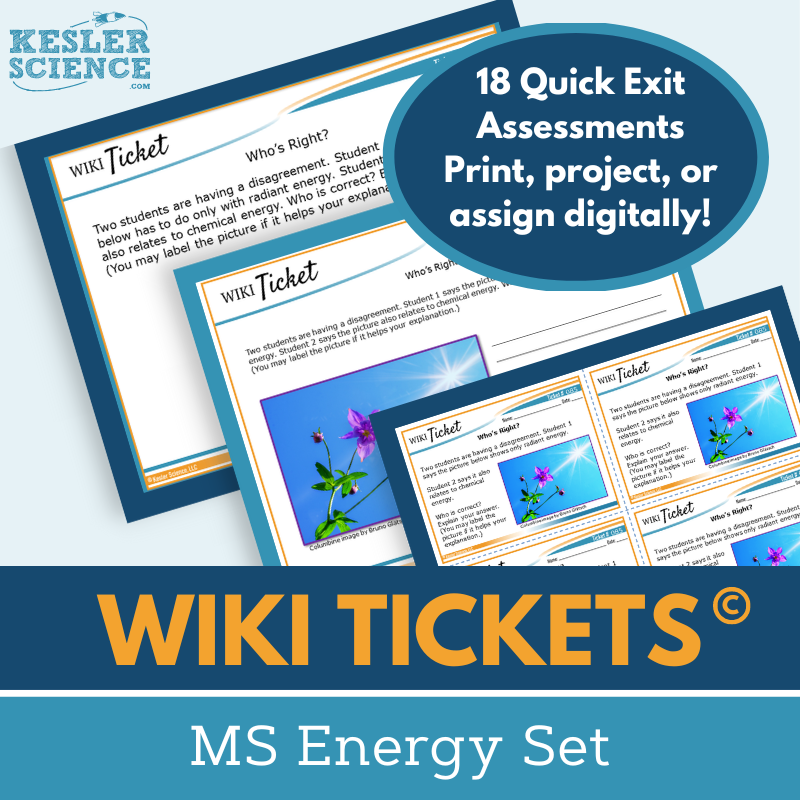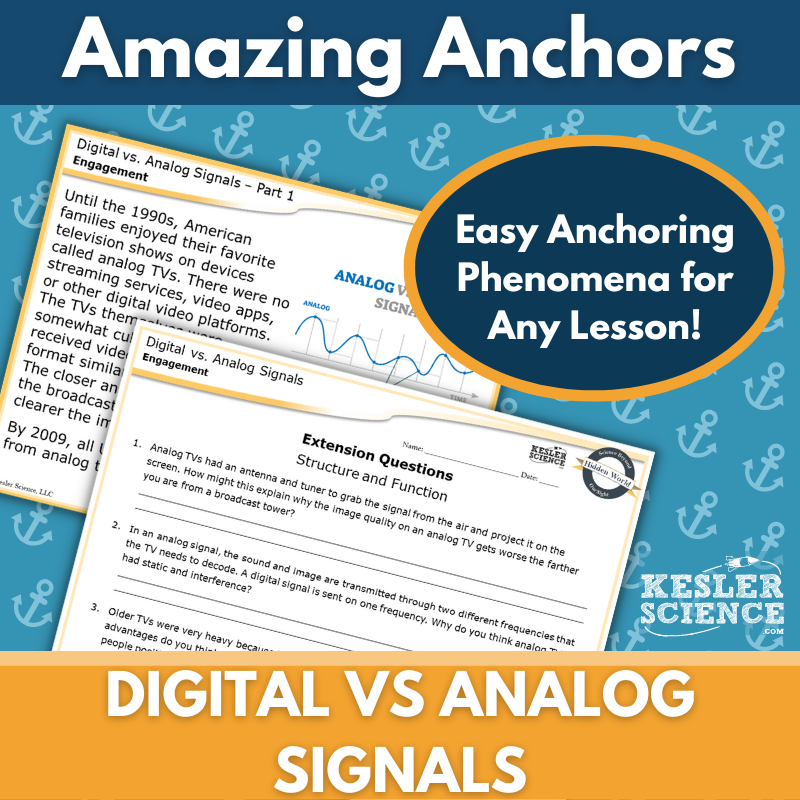Digital vs. Analog Signals Activities for Middle School Science
Students will explore the reliability of digital versus analog signals through hands-on and digital labs, reading comprehension passages, writing prompts, and engaging phenomenon-based lessons, all aligned with NGSS MS-PS4-3. The resources below will give students a comprehensive understanding of digital vs. analog signals. All of the following materials are also included in the Kesler Science Membership.
The Digital vs. Analog Signals Inquiry Lab aligns with NGSS MS-PS4-3, helping students explore why digital signals are more reliable than analog signals. This lab offers both a hands-on print experiment and a fully virtual interactive option, including a pre-recorded video demonstration. Both formats include comprehension questions, Claim-Evidence-Reasoning (C.E.R.) prompts, and a reflection section.
Students will model analog and digital signals using rolling marbles and flashing lights, then analyze signal graphs. The lab includes three differentiated levels: a dependent version with guided inquiry, a modified version with structured support, and an independent version for student-led exploration.
The print lab requires materials such as marbles, foam tubing, and a flashlight, while the digital version requires no materials and features interactive activities within a PowerPoint file compatible with Google Slides and major learning platforms. The digital version also includes a video demonstration guiding students through the lab.
Editable teacher resources include answer keys, differentiated student materials, standards and objectives, and reflection questions, ensuring flexibility and engagement in any classroom setting.
The Digital vs. Analog Signals Inquiry Lab aligns with NGSS MS-PS4-3, helping students explore why digital signals are more reliable than analog signals. This lab offers both a hands-on print experiment and a fully virtual interactive option, including a pre-recorded video demonstration. Both formats include comprehension questions, Claim-Evidence-Reasoning (C.E.R.) prompts, and a reflection section.
Students will model analog and digital signals using rolling marbles and flashing lights, then analyze signal graphs. The lab includes three differentiated levels: a dependent version with guided inquiry, a modified version with structured support, and an independent version for student-led exploration.
The print lab requires materials such as marbles, foam tubing, and a flashlight, while the digital version requires no materials and features interactive activities within a PowerPoint file compatible with Google Slides and major learning platforms. The digital version also includes a video demonstration guiding students through the lab.
Editable teacher resources include answer keys, differentiated student materials, standards and objectives, and reflection questions, ensuring flexibility and engagement in any classroom setting.
This Advantages to Digital Communication Science Reading Comprehension Lesson explores the advantages of digital technology through a nonfiction article. Designed for middle school students, the leveled passage supports science literacy and reading comprehension.
The resource includes two Lexile-leveled articles (1100-1300), five to seven comprehension questions, and a hands-on mini-project on digital television signals. A Cornell notes template is provided for additional support.
Perfect for sub plans, extra credit, ISS, or whole-class instruction, this resource fosters critical thinking, classroom discussions, and textual analysis. It is compatible with virtual learning platforms like Google Classroom, MS Teams, Schoology, and Canvas, allowing students to respond digitally.
The Advantages to Digital Communication Science Reading Comprehension Lesson explores the advantages of digital technology through a nonfiction article. Designed for middle school students, the leveled passage supports science literacy and reading comprehension.
The resource includes two Lexile-leveled articles (1100-1300), five to seven comprehension questions, and a hands-on mini-project on digital television signals. A Cornell notes template is provided for additional support.
Perfect for sub plans, extra credit, ISS, or whole-class instruction, this resource fosters critical thinking, classroom discussions, and textual analysis. It is compatible with virtual learning platforms like Google Classroom, MS Teams, Schoology, and Canvas, allowing students to respond digitally.
The Digital vs. Analog Science Writing Prompt Activity engages middle school students in testing their understanding of physical science through a creative commercial-based writing exercise. Aligned with NGSS MS-PS4-3, this activity encourages students to integrate qualitative scientific and technical information to support claims about the reliability of digitized signals compared to analog signals. Designed for both in-person and virtual learning, it enhances science reasoning, exploration, and writing skills.
This resource includes teacher directions with an answer guide, project ideas, and rubrics, as well as projection and print-friendly handouts. Full-sized and half-sheet handouts offer structured prompts, self-checks, and pre-writing strategies, while a digital interactive version in PowerPoint (compatible with Google Slides) supports remote learners. Ideal for cross-curricular activities, pre-test assessments, student choice projects, early finisher enrichment, extra credit, make-up work, TELPAS samples, and differentiation, this writing prompt fosters engagement and creativity. It also works well as a bulletin board display or student anthology collection. Designed for review, this activity assumes students have prior knowledge of the topic or access to research materials.
The Digital vs Analog Science Writing Prompt Activity engages middle school students in testing their understanding of physical science through a creative commercial-based writing exercise. Aligned with NGSS MS-PS4-3, this activity encourages students to integrate qualitative scientific and technical information to support claims about the reliability of digitized signals compared to analog signals. Designed for both in-person and virtual learning, it enhances science reasoning, exploration, and writing skills.
This resource includes teacher directions with an answer guide, project ideas, and rubrics, as well as projection and print-friendly handouts. Full-sized and half-sheet handouts offer structured prompts, self-checks, and pre-writing strategies, while a digital interactive version in PowerPoint (compatible with Google Slides) supports remote learners. Ideal for cross-curricular activities, pre-test assessments, student choice projects, early finisher enrichment, extra credit, make-up work, TELPAS samples, and differentiation, this writing prompt fosters engagement and creativity. It also works well as a bulletin board display or student anthology collection. Designed for review, this activity assumes students have prior knowledge of the topic or access to research materials.
The WIKI Tickets© Energy Set provides engaging formative assessments for 6th-8th grade science, offering flexible ways to check student understanding. This set includes 18 topics, each available in five formats: a full-screen projection version, three printable handouts (full, split, and quarter-page sizes), and an interactive digital version compatible with PowerPoint and Google Slides.
Aligned to NGSS and TEKS standards, these assessments ensure comprehensive coverage, with at least one ticket per standard. A bonus table of contents file is included for alignment reference. Designed for both in-person and virtual learning, WIKI Tickets© can be used as exit tickets, bellringers, or quick checks. Topics covered include energy transformations, digital and analog signals, wave characteristics, wave models, and more. Students can respond on printed handouts, their own paper, or digitally in a 1:1 or remote setting. These vibrant, ready-to-use assessments help you gauge student progress effectively in any learning environment.
The WIKI Tickets© Energy Set provides engaging formative assessments for 6th-8th grade science, offering flexible ways to check student understanding. This set includes 18 topics, each available in five formats: a full-screen projection version, three printable handouts (full, split, and quarter-page sizes), and an interactive digital version compatible with PowerPoint and Google Slides.
Aligned to NGSS and TEKS standards, these assessments ensure comprehensive coverage, with at least one ticket per standard. A bonus table of contents file is included for alignment reference. Designed for both in-person and virtual learning, WIKI Tickets© can be used as exit tickets, bellringers, or quick checks. Topics covered include energy transformations, digital and analog signals, wave characteristics, wave models, and more. Students can respond on printed handouts, their own paper, or digitally in a 1:1 or remote setting. These vibrant, ready-to-use assessments help you gauge student progress effectively in any learning environment.
Lesson Extensions provide engaging, student-choice activities designed to challenge early finishers and deepen their understanding of energy concepts. These activities encourage critical thinking, creativity, and problem-solving while preventing distractions and making use of downtime. Aligned to NGSS and TEKS energy standards, they support independent learning and enrichment.
Each extension includes four interactive components: Puzzler for problem-solving, Maker Space for hands-on STEAM activities, Tech Connection for digital demonstrations, and Word Master for creative writing. With teacher directions, answer keys, and both print and projection versions, these extensions offer flexible, rigorous learning opportunities.
Covering topics such as energy transformations, kinetic and potential energy, thermal energy transfer, the electromagnetic spectrum, and photosynthesis, these extensions help students explore energy concepts in a meaningful way. Perfect for lesson wrap-ups, early finishers, or independent challenges, Lesson Extensions ensure continued engagement and deeper learning.
Lesson Extensions provide engaging, student-choice activities designed to challenge early finishers and deepen their understanding of energy concepts. These activities encourage critical thinking, creativity, and problem-solving while preventing distractions and making use of downtime. Aligned to NGSS and TEKS energy standards, they support independent learning and enrichment.
Each extension includes four interactive components: Puzzler for problem-solving, Maker Space for hands-on STEAM activities, Tech Connection for digital demonstrations, and Word Master for creative writing. With teacher directions, answer keys, and both print and projection versions, these extensions offer flexible, rigorous learning opportunities.
Covering topics such as energy transformations, kinetic and potential energy, thermal energy transfer, the electromagnetic spectrum, and photosynthesis, these extensions help students explore energy concepts in a meaningful way. Perfect for lesson wrap-ups, early finishers, or independent challenges, Lesson Extensions ensure continued engagement and deeper learning.
This Amazing Anchors Phenomenon Lesson engages students in the science of digital and analog signals through a real-world example. It begins with an introductory reading focused on analog televisions, followed by comprehension and extension questions to help students build foundational knowledge. An explanatory reading then breaks down the differences between digital and analog signals in an accessible way, with additional questions to reinforce key concepts.
Aligned with NGSS standard MS PS4-3, this no-prep resource includes teacher directions, answer keys, and editable materials for flexibility in any classroom setting. It is available in both print and digital formats, including projection slides, full- and half-sheet handouts, and PowerPoint files for use in Google Classroom or other LMS platforms. A modified version provides differentiated support with sentence starters to assist students in answering comprehension questions.
Designed to bookend a lesson, this Amazing Anchors resource serves as a valuable supplement to any science curriculum. The before-and-after readings support the Engagement and Elaborate phases of a 5E lesson, helping students make meaningful connections to real-world applications. Whether used in-person or virtually, this activity encourages curiosity and deeper understanding of digital and analog signals.
This Amazing Anchors Phenomenon Lesson engages students in the science of digital and analog signals through a real-world example. It begins with an introductory reading focused on analog televisions, followed by comprehension and extension questions to help students build foundational knowledge. An explanatory reading then breaks down the differences between digital and analog signals in an accessible way, with additional questions to reinforce key concepts.
Aligned with NGSS standard MS PS4-3, this no-prep resource includes teacher directions, answer keys, and editable materials for flexibility in any classroom setting. It is available in both print and digital formats, including projection slides, full- and half-sheet handouts, and PowerPoint files for use in Google Classroom or other LMS platforms. A modified version provides differentiated support with sentence starters to assist students in answering comprehension questions.
Designed to bookend a lesson, this Amazing Anchors resource serves as a valuable supplement to any science curriculum. The before-and-after readings support the Engagement and Elaborate phases of a 5E lesson, helping students make meaningful connections to real-world applications. Whether used in-person or virtually, this activity encourages curiosity and deeper understanding of digital and analog signals.
This Spangler Phenomenon lesson on analog and digital signals features an exclusive Steve Spangler video for Kesler Science. Students will engage in an interactive investigation exploring the question: How does the design of modern technology help it operate more reliably than older technology?
Designed using the 5E framework, this lesson aligns with NGSS middle school physical science standards. It incorporates the crosscutting concept of structure and function, along with the science and engineering practice of obtaining, evaluating, and communicating information.
In Think Like a Scientist, students analyze phenomena related to analog and digital signals, inspired by the Black Light Secret Message video. In Study Like a Scientist, they gather information from an engaging article, with opportunities to expand learning through Station Labs or Inquiry Labs. In Work Like a Scientist, students refine their understanding after watching an exclusive Steve Spangler explanation video, then apply their knowledge through writing, drawing, or building activities.
Each lesson includes teacher directions, student handouts, two Steve Spangler videos, presentation slides in standard and digital interactive formats, and Vimeo links for ad-free viewing. File formats include PowerPoint and PDF, with compatibility for Google Slides.
This Spangler Phenomenon lesson on analog and digital signals features an exclusive Steve Spangler video for Kesler Science. Students will engage in an interactive investigation exploring the question: How does the design of modern technology help it operate more reliably than older technology?
Designed using the 5E framework, this lesson aligns with NGSS middle school physical science standards. It incorporates the crosscutting concept of structure and function, along with the science and engineering practice of obtaining, evaluating, and communicating information.
In Think Like a Scientist, students analyze phenomena related to analog and digital signals, inspired by the Black Light Secret Message video. In Study Like a Scientist, they gather information from an engaging article, with opportunities to expand learning through Station Labs or Inquiry Labs. In Work Like a Scientist, students refine their understanding after watching an exclusive Steve Spangler explanation video, then apply their knowledge through writing, drawing, or building activities.
Each lesson includes teacher directions, student handouts, two Steve Spangler videos, presentation slides in standard and digital interactive formats, and Vimeo links for ad-free viewing. File formats include PowerPoint and PDF, with compatibility for Google Slides.
Year-Round Resources
These year-round activities will increase your students' understanding of many middle school science topics. All of these activities are also included in the Kesler Science Membership.
Visual Data & Graphing
You're not alone if your students struggle with understanding graphs, charts, and tables. It's a skill that takes an enormous amount of practice. This resource will help students build a strong foundation in analyzing data and creating their own data visualizations.
Bell Ringers and Warm-Ups
These middle school science bell ringers are an excellent way to engage your students as soon as they walk into your classroom. This comprehensive FULL YEAR resource includes everything you need to start off each science class with an interesting warm-up activity.
Review Board Games
Each game board has been carefully designed to keep students engaged. There are 10 different action spaces on each board and dozens of question cards. All of the actions are related to science concepts and keep the students motivated throughout the game.
Each game is ready to play. Simply print out the board and the cards and let the students enjoy reviewing nine different units.
Essential Questions and Standards
Below are the essential questions and standards associated with the lessons and activities included in the digital vs analog signals unit. This topic is only one of more than 100 middle school science topics included in the Kesler Science Membership.
-
Why are digital signals more reliable than analog signals?
-
NGSS - MS-PS4-3 Digital vs Analog Signals
Kesler Science Membership
Imagine never having to search for another middle school science lesson again. The membership gives you access to ALL of the Kesler Science products in one place (Yes, including everything above).
Say goodbye to long hours of lesson prep.















